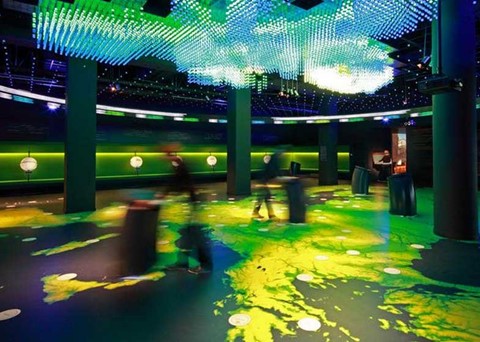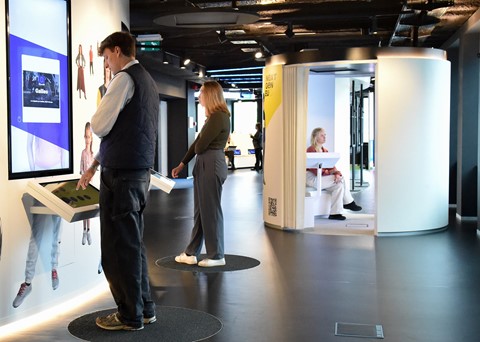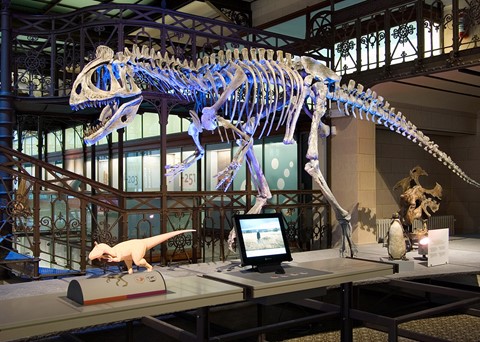Haus der Europäischen Geschichte
Der Eintritt ist frei und Tablets in den 24 Amtssprachen der Europäischen Union sind verfügbar.
Das Herzstück des Hauses der Europäischen Geschichte sind die Galerien der Dauerausstellung, die mit Hilfe von Objekten, Rekonstruktionen und Multimedia-Ressourcen die BesucherInnen auf eine zum Nachdenken anregende Reise durch das 19. und 20. Jahrhundert mitnehmen.
Das Museum zeigt regelmäßig Wechselausstellungen, zum Beispiel zum Thema Abfall in Europa, Desinformation oder auch Kunstwerke in Kriegszeiten.
ENTDECKEN SIE DIE AKTUELLE WECHSELAUSSTELLUNG AUF DER WEBSITE.
Lehrkräfte und Studenten
Lernhilfen und Ressourcen sind sowohl vor Ort als auch online verfügbar.
Auch stehen herunterladbare Lehrernotizen, Klassen- und Gruppenaktivitäten, sowie Fotos, schriftliche Zeugnisse und Videos zur Verfügung.
Diese Materialien können leicht an den Lehrplan angepasst werden.
Familien
Bedienen Sie sich für Familien mit Kindern zwischen 6 und 10 Jahren mit einem Rucksack und erleben Sie eine Zeitreise durch verschiedene Epochen der europäischen Geschichte! Kinder werden Geschichte riechen, fühlen und erleben wie nie zuvor, indem sie bei dem Rollenspiel in einem Reisebüro der 1960er Jahre mitmachen, in die Schuhe eines Astronauten schlüpfen oder sich mit Robotern auseinandersetzen.
Die Family Spaces sind in 24 Sprachen verfügbar und während der Öffnungszeiten des Museums zugänglich. Zusätzliche betreute Lernaktivitäten finden Mittwoch, Samstag und Sonntag von 14:00 bis 17:00 Uhr statt. Der Eintritt ist frei. Eine Reservierung ist nicht erforderlich.
Das Museum ist familienfreundlich und verfügt über Wickelplätze und einen Kinderwagenzugang. Eltern sollten bedenken, dass bestimmte Aspekte der Dauerausstellung erst für Kinder ab elf Jahren geeignet sind.

- Montag : -
- Dienstag : -
- Mittwoch : -
- Donnerstag : -
- Freitag : -
- Samstag : -
- Sonntag : -
- T. +32 2 283 12 20
- Rue Belliard 135 Belliardstraat - 1000 Brüssel
- https://historia-europa.ep.eu/
- historia@europarl.europa.eu
-
Öffnungszeiten
29/03/2025 - 11/01/2026: * lundi: de 13:00 à 18:00 * mardi, mercredi, jeudi et vendredi: de 09:00 à 18:00 * samedi et dimanche: de 10:00 à 18:00
Bien loin de se cantonner aux musées ou aux livres, l’histoire joue un rôle important dans la vie de chacun et chacune : visites de lieux devenus touristiques, commémorations et reconstitutions d’évènements, fouilles, collections d’objets anciens… Les interactions avec le passé peuvent prendre des formes multiples, et avoir des buts divers, comme renforcer des liens dans un groupe, construire son identité, se divertir ou encore se souvenir de certains drames du passé. Afin d’évoquer tous ces rapports que les Européennes et les Européens peuvent entretenir avec l’histoire, l’exposition « Passé composé. Un album européen » est divisée en sept grandes sections : L’attrait touristique des sites historiques, lieux de pèlerinage dont on profite parfois uniquement pour nos réseaux sociaux ; Les nouvelles formes de commémorations qui, à l’ère post-héroïque, mettent en lumière les soldats et victimes civiles, sans plus se concentrer sur les seuls chefs militaires ; Les reconstitutions historiques, pratiquées depuis des décennies mais qui connaissent depuis peu un regain de popularité ; La fabrique des héros, pour interroger les mécanismes à l’œuvre dans des cultes de la personnalité tantôt spontanés, tantôt forcés par l’État ; La décommémoration, pour évaluer les solutions possibles face aux monuments hérités du passé, liés par exemple à la colonisation, l’esclavage ou aux régimes dictatoriaux ; Le passé comme paysage, lorsque la nature reprend peu à peu ses droits sur des lieux marqués par des histoires tragiques ; Les historiennes et les historiens du quotidien qui partent à la recherche d’objets anciens, les collectent ou les exposent pour s’ancrer dans le passé de leur famille, pays ou communauté. La Maison de l’histoire européenne collabore pour cette exposition avec l’Atelier de photographie de l’École nationale supérieure des arts visuels de La Cambre (Bruxelles). Six des 21 photographes dont le travail sera exposé en sont issus et présenteront ainsi le point de vue de la jeune génération sur la manière dont l'histoire imprègne notre quotidien. Le public est invité à découvrir l'historienne ou l’historien qui sommeille en elle ou en lui grâce aux activités interactives de l'exposition.
-
Öffnungszeiten
27/06/2025 - 31/10/2025: * lundi: de 13:00 à 18:00 * mardi, mercredi, jeudi, vendredi, samedi et dimanche: de 10:00 à 18:00
Présentées dans un décor audiovisuel qui recrée l'atmosphère de la ville, de son métro à ses parcs en passant par les maisons de ses habitants, les histoires racontées dans « Raising our roots » contrastent avec l'histoire européenne telle qu'elle est présentée dans les musées, en mettant en avant des réalités intimes bruxelloises et des récits sur la migration à travers le temps. Les visiteurs découvriront ainsi les multiples facettes d'une ville en constante évolution. Le processus participatif Les membres du collectif Echoes, sélectionnés à l'issue d'un appel à candidatures, ont été invités à travailler ensemble dans le cadre d'un projet d'une année. Ils ont identifié des voix inaudibles et des récits manquants dans l'histoire, et ont développé un intérêt particulier pour la manière dont les histoires de migration sont racontées. Les participants d'Echoes ont ensuite parcouru les rues et les maisons de Bruxelles à la recherche d'histoires inédites et de témoignages personnels sur la migration et l'appartenance. Ils ont transformé ces histoires en contenu audiovisuel, qui amplifie les voix de l'histoire et de Bruxelles, mettant ainsi leurs racines en lumière.
« Slow Looking Saturday » est une série de rendez-vous avec un ou une guide qui se déroule pendant l'exposition temporaire « Passé composé - un album européen ». Tous les premiers samedis du mois à 14h30, venez approfondir pendant une heure un sujet de l'exposition à travers une photographie particulière. Le ou la guide vous accompagnera, vous et le groupe, pour regarder une photographie à un rythme différent et prendre le temps d'y réfléchir. L’ensemble des séances couvrira toutes les salles de l'exposition, à travers la pratique du Slow Looking et la découverte de faits historiques basés sur les observations et les réflexions du groupe. Veuillez vous inscrire à l'avance à la session à laquelle vous souhaitez assister, afin de garantir votre place et de recevoir un rappel avant l'événement. Les visiteurs inscrits auront la priorité, mais vous pouvez également vous rendre au musée et voir s'il reste des places disponibles le jour même. Pour garantir une expérience agréable, la taille idéale d'un groupe est d'environ 15 personnes. Si vous n'êtes pas inscrit à l'avance, la règle du « premier arrivé, premier servi » sera appliquée. Calendrier Slow Looking Saturday 5 juillet – Destination : Histoire Focus sur « Méditerranée. La continuité de l'homme » de Nick Hannes – un regard sur les comportements touristiques, parfois troublants, dans les sites patrimoniaux. Inscrivez-vous dès maintenant. 2 août – Décommémoration Focus sur « Laver le passé » de Ria Pacquée – qui retrace le nettoyage d'un monument de Léopold II à Ostende, en Belgique, que des activistes avaient aspergé de peinture rouge. Inscrivez-vous dès maintenant. 6 septembre – Reconstitutions Focus sur « Nostalgie de la boue » par Hugo Passarello Luna – un regard contemporain à travers un appareil photo de la Première Guerre mondiale sur les reconstitutions. Inscrivez-vous dès maintenant. 4 octobre – Le passé comme paysage Focus sur « The Last Stand » par Marc Wilson – un point culminant sur les vestiges physiques de la guerre dans la nature. Inscrivez-vous dès maintenant. 1er novembre – Musée fermé, pas de Slow Looking Saturday. 6 décembre – Let's make history ! Focus sur les séries de photos disponibles dans l'exposition interactive « Let's make history ! » – cette session établit des liens avec le reste de l'exposition et enregistre des détails qui pourraient bientôt disparaître ! Inscrivez-vous dès maintenant. Practical information - Meet the guide at 14:30 in the Fables Room, just before the entrance of the temporary exhibition. - Please be aware that to enter the museum, you would pass through security checks which can take some time. Please arrive 10 minutes in advance. The activity will be held in English. - The activity is suitable for people aged 16 years old and over. - Registration is recommended in advance.









